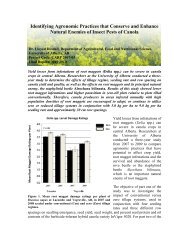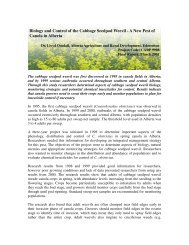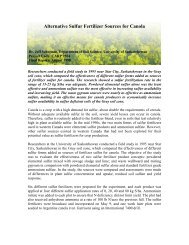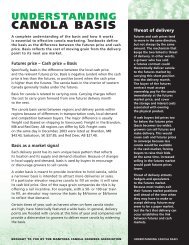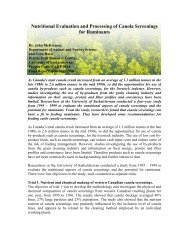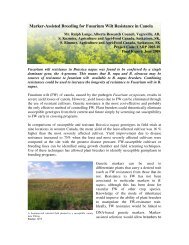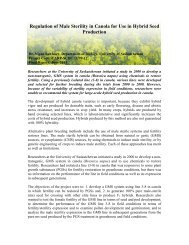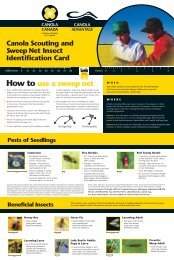Canola Digest, January 2013 - SaskCanola
Canola Digest, January 2013 - SaskCanola
Canola Digest, January 2013 - SaskCanola
You also want an ePaper? Increase the reach of your titles
YUMPU automatically turns print PDFs into web optimized ePapers that Google loves.
JOHN GUELLY<br />
Westlock, Alberta<br />
@WheatGeerJJ<br />
John Guelly signed up for Twitter after<br />
hearing a presentation by Shaun Haney<br />
of RealAgriculture.com at Farm Tech in<br />
Edmonton. One of the biggest benefits<br />
to Twitter, Guelly says, is rapid response<br />
to agronomy issues. In 2011, a hail storm<br />
went through his area just before swathing<br />
and a lot of growers were wondering<br />
whether to swath that day or leave what<br />
was left of the crop to reach a more<br />
appropriate swathing stage. On short<br />
notice, Rick Taillieu from Alberta <strong>Canola</strong><br />
Producers Commission and Doug Moisey,<br />
the <strong>Canola</strong> Council of Canada’s agronomy<br />
specialist for the region at the time, used<br />
Twitter to organize a field walk around<br />
Westlock to discuss options.<br />
“That was a big learning experience,<br />
and it was organized quickly through<br />
Twitter,” says Guelly.<br />
Another time he found a cutworm he<br />
couldn’t identify and sent around a photo<br />
through Twitter. “Pretty soon we had<br />
a conversation going, and I learned the<br />
cutworm species, as well as prevention<br />
measures and control thresholds.”<br />
To chop or not to chop?” She was<br />
immediately involved in a conversation<br />
about straw management and heavy<br />
harrowing options and timing.<br />
When scouting fields for bertha<br />
armyworm, Murphy tweeted people like<br />
@ABBugCounter for more information.<br />
“In fact, I found worms that I suspected<br />
to have nuclear polyhedrosis virus,<br />
which prompted some cool Twitter<br />
discussions. With this discovery, along<br />
with knowledge of thresholds and<br />
pre-harvest intervals – thanks to Twitter<br />
resources and links – I chose not to<br />
spray any insecticides,” she says. “After<br />
swathing, I found many more infected<br />
bugs and determined that I had made<br />
the right choice.”<br />
“I live in a very remote area,<br />
but since I joined Twitter, I feel<br />
a part of something bigger –<br />
a community, a team.”<br />
– Debra Murphy<br />
Twitter can also provide comfort.<br />
“When we were hit with wind and<br />
hail and our canola swaths were over<br />
60 percent damaged, I looked to Twitter<br />
for reassurance, guidance and support,”<br />
says Murphy. “A lot of farmers were<br />
struggling with wind, hail and fire<br />
damage at around the same time, and<br />
I found comfort in our discussions.”<br />
“It’s really amazing how much Twitter<br />
has helped me,” she says. “I live in a very<br />
remote area, but since I joined Twitter,<br />
I feel a part of something bigger –<br />
a community, a team. I am learning so<br />
much, and seeing the intense passion<br />
so many people have for our industry.”<br />
JASON REMPEL<br />
Ste. Anne, Manitoba<br />
@rumpus204<br />
Jason Rempel started to actively use<br />
Twitter after a Canadian Young Farmers<br />
best management practices workshop<br />
last year. A group at the workshop saw<br />
the value in social media for ag producers,<br />
so they decided to get more involved.<br />
“Now I have a large community I can<br />
tap into to get help with my headaches<br />
of the day,” he says. “Twitter is really<br />
conducive to the smartphone office.<br />
With the concise messages, I can pose<br />
a question or provide an answer while<br />
dumping a load of grain, for example.”<br />
Or, if he’s trying to modify a piece of<br />
equipment, Rempel can quickly describe<br />
his plan on Twitter and ask where he can<br />
get parts. “It will get a conversation<br />
going and I’ll usually get answers.”<br />
This fall and winter, Rempel has been<br />
in conversations about fall fertilizer<br />
application and new canola varieties.<br />
“Growers will tweet about their<br />
experiences with certain varieties, and<br />
I’ll definitely use that information in<br />
addition to other sources when making<br />
my seed decisions.”<br />
Guelly considers short messages to<br />
be a Twitter advantage. “I can breeze<br />
through them pretty quickly, and<br />
sort out what I want to read,” he says.<br />
“If I want more information, many<br />
tweets include a link.” •<br />
Jay Whetter is communications manager<br />
with the <strong>Canola</strong> Council of Canada.<br />
He is also editor of the CCC’s free <strong>Canola</strong><br />
Watch agronomy newsletter. Go to<br />
www.canolawatch.org and find the sign up<br />
box down the right column.<br />
21<br />
CANOLA DIGEST JANUARY <strong>2013</strong>



